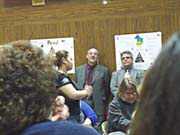On four consecutive Monday mornings during the school year, teachers in the elementary schools hand out an unusual assignment to students in the fourth, fifth and sixth grades. Although it has a homework component, the lesson deals not with mathematics, writing, history or science, but about how to avoid drug use.
The program, called “Keep a Clean Mind,” consists of four components on alcohol, tobacco, marijuana and tools needed to resist drug use.
“We give this to each classroom teacher in those grades,” said Pat Cocucci, principal of Huber Street school, last week.
In the classroom, the teacher provides students with a brief introduction to that week’s topics, then issues a lesson for the student to take home to his or her parent or guardian.
This lesson is completed by the child and guardian, and involves answering a handful of relatively simple questions on identifying peer pressure to use drugs and how to respond. These lessons talk about the hazards of drug use and how frequently peer pressure is the cause for kids to take up drugs. The lesson also talks about the variety of reasons not to use drugs, and how to say no.
The program, designed at the University of Arizona in the late 1980s, evolved out of Nancy Reagan’s “Just Say No” campaign, and continued the concept that the most effective way to battle drug use in America is to teach kids to reject drugs at an early age. In this theory, the earlier a child learns about the dangers of drugs, the less likely that child will get involved with drugs at a later date.
In a school district like Secaucus, where a recent survey showed a stable, yet significantly high risk of drug and alcohol use in higher grades – especially among high school seniors – drug and alcohol prevention personnel like Jill Pries said education in the lower grades becomes vital.
Although the Secaucus Police Department has expanded its own anti-drug program, DARE, over the last decade to cover this same population of kids by providing classroom programs on the use and dangers of drugs, “Keep a Clear Mind,” Pries noted, takes the program into the home – where parents and children have the opportunity to discuss the social issues surrounding drug use and to develop strategies that will keep kids from using drugs.
“We have heard positive things from our parents about this program,” Cocucci said.
At the beginning of each week, the classroom teacher sends a lesson home with each student and the parent listens as the student answers the questions. The parent evaluates how well the student did in answering these questions, then signs a form that is returned to the school. Students then receive small incentives for their efforts, such as a bookmark, pencil, a sticker or even a T-shirt.
The program deliberately focuses on fourth through sixth grades in order to alert kids and parents to the dangers of what experts call “gateway” drugs (i.e. tobacco, alcohol and marijuana), which can start kids into using harder drugs later.
Ralph Merlo, principal of Clarendon School, sent a letter to parents last October telling them what to expect.
Two published studies done on the program in the 1990s by the University of Arkansas showed a significant increase in parent awareness because of this program and a significant drop in later drug use by students who participated.
Through a combination of programs, school officials hope to get kids to say no to drugs.
“One of the most important findings of researchers in the last several years is that the more often children hear credible prevention messages, and the more places that they hear the same messages, the more likely they are to pay attention to those messages,” stated school officials in a release with the results of their recent district-wide drug survey. “Any adult that plays a role in a child’s life can help to communicate these messages.”
